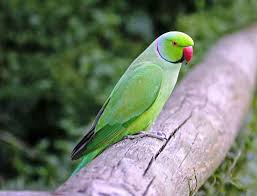African Ring-Necked Parakeet

Description
The African Ring-Necked Parakeet (Psittacula krameri), also known as the rose-ringed parakeet, ring-necked parakeet, is a medium-sized parrot in the genus Psittacula of the family Psittacidae that has a very wide range.
The rose-ringed parakeet is sexually dimorphic. The adult male sports a red and black neck ring and the hen and immature birds of both sexes either show no neck rings, or display shadow-like pale to dark grey neck rings. Both sexes have a distinctive green colour. Rose-ringed parakeets measure on average 40 cm (16 in) in length, including the tail feathers, a large portion of their total length. Their average single-wing length is about 15 to 17.5 cm (5.9 to 6.9 in). In the wild, this is a noisy species with an unmistakable squawking call, and captive individuals can be taught to speak. It is herbivorous and not migratory.
One of the few parrot species that have successfully adapted to living in disturbed habitats, it has withstood the onslaught of urbanisation and deforestation. As a popular pet species, escaped birds have colonised a number of cities around the world, including Northern and Western Europe. Since the population appears to be increasing, the species was evaluated as being of least concern by the IUCN in 2012, but its popularity as a pet and unpopularity with farmers have reduced its numbers in some parts of its native range.
Parakeets in Garaboli National Park making a beak-lock – a common act in parakeet pairs
The genus name Psittacula is a diminutive of Latin psittacus, "parrot", and the specific krameri commemorates the Austrian naturalist Wilhelm Heinrich Kramer.
Four subspecies are recognized, though they differ little:
- African subspecies:
African rose-ringed parakeet (P. k. krameri): western Africa in Guinea, Senegal, and southern Mauritania, east to western Uganda and southern Sudan, Egypt. Resident among the Nile valley and certainly Giza, it is sometimes seen on the north coast and Sinai. The African parakeet also started to breed in Israel in the 1980s and is considered an invasive species.
Abyssinian rose-ringed parakeet (P. k. parvirostris): northwest Somalia, west across northern Ethiopia to Sennar district, Sudan
- Asian subspecies:
Indian rose-ringed parakeet (P. k. manillensis) originates from the southern Indian subcontinent and has feral and naturalized populations worldwide. In Australia, Great Britain (mainly around London), the United States, and other western countries, it is often referred to as the Indian ringneck parrot.
Boreal rose-ringed parakeet (P. k. borealis) is distributed in Bangladesh, Pakistan, northern India and Nepal to central Burma; introduced populations are found worldwide.
The Indian subspecies are both larger than the African subspecies.
Scientific Name
Psittacula krameri krameri
Country Of Origin
Africa
Size
Small, up to 9 inches
Life Expectancy
up to 50 years
Noise Level
Low
Talk / Trick Ability
Moderate; can learn to talk if taught young and likes to learn new tricks
Characteristics
African ring-necked parakeets are affectionate birds that needs enough attention to keep it from getting bored, but enough independence to spend time alone on a play gym. African ring-necked parakeets are shy and quieter than Indian ring-necked parakeets. They need to be handled and socialized often when young in order to keep them tame. African ring-necked parakeets enjoy bathing with their owners while staying on a shower perch to catch drops of water. They make good companions that can be taught to snuggle and perform elaborate tricks.
Behavior / Health Concerns
African ring-necked parakeets enjoy a diet filled with fresh fruits, vegetables, pellets, parrot seed mixtures, cuttlebone and fresh water. Both the male and female are primarily light green with a greenish-yellow hue on the under parts. The male has a black stripe across the mandible that circles the neck and extends to its rose pink collar washed with a light blue. Male African ring-necked parakeets also have a light blue and thin black line across the beak and to the eyes. Females lack the rose pink collar, blue on the neck and the thin black mandible stripe. Instead of a black ring, found on the males, the females have a light green collar and only a hint of the black line leading to the eyes.